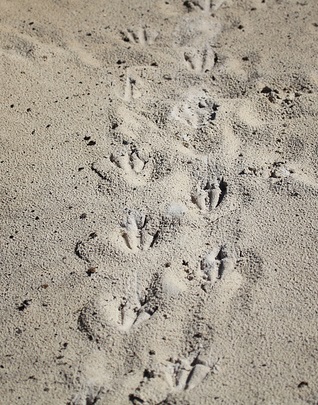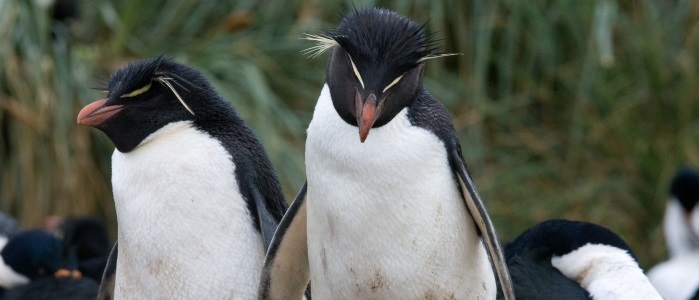Form & Function
The Southern Rockhopper penguin varies in si ze
from males to females. Males tend to be slightly larger than the
females. Both sexes, however, have the characteristic yellow stripe
above their eyes. Their eyes are red with a red-brown beak and pink legs
and feet (Bingham 2014).
ze
from males to females. Males tend to be slightly larger than the
females. Both sexes, however, have the characteristic yellow stripe
above their eyes. Their eyes are red with a red-brown beak and pink legs
and feet (Bingham 2014).
Penguins prove to be a unique organism in one particular aspect
of their physiology. It’s common to think that everything that
has wings should be able to fly; however, in the case of the
Southern Rockhopper penguin, its wings are completely useless in
flight (Dehnhard et al. 2013a). Instead, the wings are used in
the water and act as fins or flippers to help the penguin
maneuver throughout the water. Water is only one medium of
locomotion for penguins, though. They also can walk and use
their tails and wings for balance.
Overall, Southern Rockhopper penguins do not adjust well to
changes in their environment. When an environmental change
occurs and conditions
 become unfavorable, Southern Rockhopper
penguins face serious devastation. Breeding success is
diminished and can be impeded completely along with an increase
in adult mortality. The combination of these problems results in
fluctuations in the number of penguins in a population (Dehnhard
et al. 2013b). For example,
a study has shown that Eudyptes
chrysocome reacts sensitively to the environmental change in sea
surface temperatures (SST; Dehnhard et al. 2013a) because SST
changes decrease food availability at low trophic levels
(Dehnhard et al. 2013b). Decreased food availability
equates to limited prey, and because these penguins feed mostly on prey
toward the bottom of the food chain, they are impacted immediately. This
can be especially dangerous during molting periods because the molting
process requires more energy than penguins typically need (Dehnhard
et
al. 2013a).
become unfavorable, Southern Rockhopper
penguins face serious devastation. Breeding success is
diminished and can be impeded completely along with an increase
in adult mortality. The combination of these problems results in
fluctuations in the number of penguins in a population (Dehnhard
et al. 2013b). For example,
a study has shown that Eudyptes
chrysocome reacts sensitively to the environmental change in sea
surface temperatures (SST; Dehnhard et al. 2013a) because SST
changes decrease food availability at low trophic levels
(Dehnhard et al. 2013b). Decreased food availability
equates to limited prey, and because these penguins feed mostly on prey
toward the bottom of the food chain, they are impacted immediately. This
can be especially dangerous during molting periods because the molting
process requires more energy than penguins typically need (Dehnhard
et
al. 2013a).
Back To Habitat & Geography
Home
References Contact Us
Continue To Life History & Reproduction

